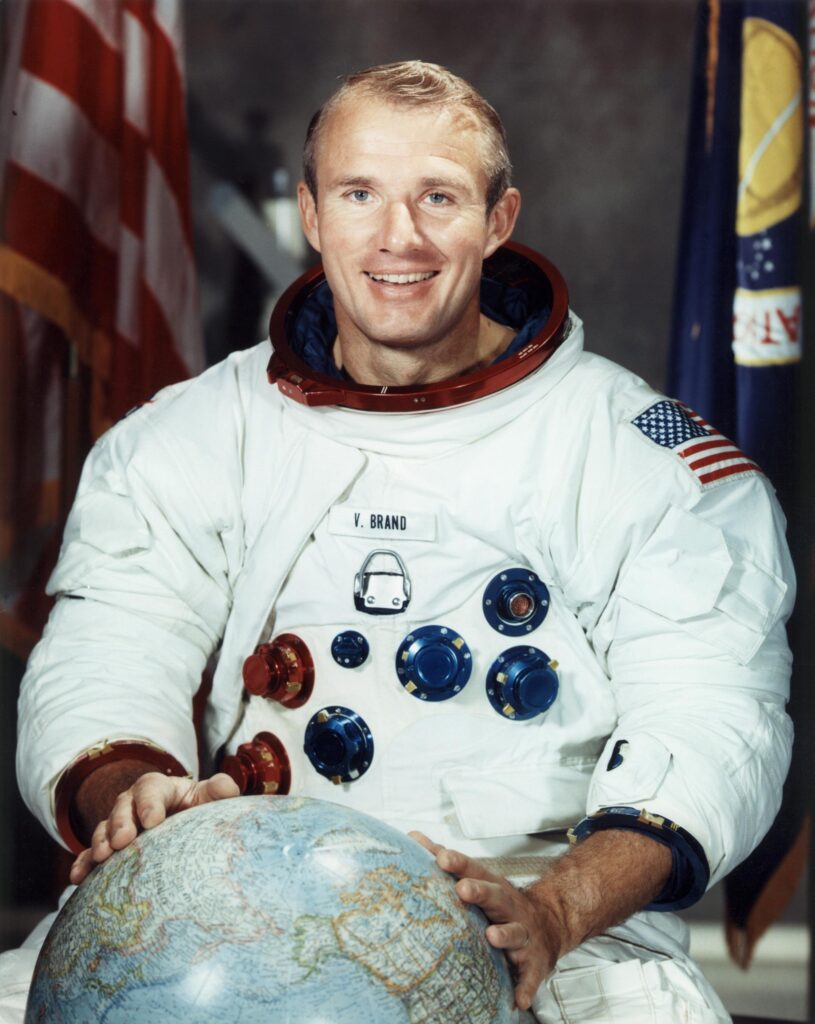Vance DeVoe Brand was born in Longmont, Colorado, May 9, 1931. A graduate of Longmont High School, he earned a Bachelor of Science degree in Business from the University of Colorado in 1953, a Bachelor of Science degree in Aeronautical Engineering from the University of Colorado in 1960, and a Master’s degree in Business Administration from the University of California at Los Angeles in 1964.
Brand was a commissioned officer and naval aviator with the U.S. Marine Corps from 1953 to 1957. His military assignments included a fifteen-month tour in Japan as a jet fighter pilot. Following release from active duty, Brand continued in Marine Corps Reserve and Air National Guard jet fighter squadrons until 1964.
Vance Brand worked for the Lockheed Aircraft Corporation from 1960 to 1966, initially as a flight test engineer on the Navy’s P3A aircraft. In 1963, he graduated from the U.S. Naval Test Pilot School and was assigned to Palmdale, California as an experimental test pilot on Canadian and German F-104 programs. Prior to selection to the astronaut program in 1966, Brand worked at the West German F-104G Flight Test Center at Istres, France as an experimental test pilot and leader of a Lockheed flight test advisory group. Brand has logged 9,669 flying hours, which includes 8,089 hours in jets, and 391 hours in helicopters. He is checked out in more than 30 types of military aircraft.
Brand’s first space flight came on July 15, 1975, as the Apollo Command Module pilot on the Apollo-Soyuz Test Project mission. This flight resulted in the historic first meeting in space between American astronauts and Soviet cosmonauts. Other crewmen on this nine-day Earth-orbital mission were Thomas Stafford, Apollo Commander; Donald Slayton, Apollo Docking Module pilot; cosmonaut Alexei Leonov, Soyuz Commander; and cosmonaut Valery Kubasov, Soyuz Flight Engineer.
The Soyuz spacecraft was launched at Baikanor Cosmodrome in Central Asia seven and a half hours before the Apollo craft lifted off from the Kennedy Space Center (KSC), Florida. Two days later, on July 17, the Apollo capsule accomplished a successful rendezvous and docking with the Soyuz craft. The linkup tested a unique, new docking system and demonstrated international cooperation in space. There were 44 hours of docked joint activities, including four crew transfers between the Apollo and the Soyuz. Twenty-eight experiments were performed during the flight and six records for docked and group flight were established. The Apollo command module splashed down in the Pacific Ocean near Hawaii, on July 25, 1975 less than a mile from the targeted splash down point ending the 217-hour mission.
Vance Brand next entered space as Commander of STS-5 Columbia, the first fully operational flight of the Shuttle Transportation System (STS), launched from KSC on November 11, 1982. STS-5, the first shuttle mission with a four-man crew demonstrated the shuttle was operational by successfully deploying two commercial communications satellites from the Orbiter’s payload bay. The mission marked the shuttle’s first use of an upper stage rocket, the Payload Assist Module, a spin-stabilized, solid-fueled rocket motor, designed to boost satellites deployed in near Earth orbit. Columbia landed at Edwards Air Force Base, California on November 16, 1982, after a mission of 122 hours.
Brand next commanded STS 41-B Challenger, the tenth flight of the Space Shuttle, launched from KSC on February 3, 1984. This mission marked the first flight checkout of the Manned Maneuvering Unit and the Manipulator Foot Restraint. Astronauts Bruce McCandless and Robert Stewart performed two extravehicular activities (EVA’s), testing these units. Shuttle rendezvous sensors and computer programs were flight tested for the first time as well. STS 41-B ended with the first shuttle landing at KSC on February 11, 1984 after a flight of 191 hours.
Brand’s last space mission was as Commander of STS-35 Columbia. A night launch on December 2, 1990 started the nine-day mission, which was devoted to observations of stars and other celestial objects. This shuttle flight, the first dedicated to astronomy, provided a rich return of science data with emphasis on observation of very active celestial objects. A night landing was made on December 10 at Edwards Air Force Base after 215 hours in space. Brand logged over 746 hours, more than 31 days and two hours, in space during his four missions.
Vance Brand departed the Astronaut Office in 1992 to become Chief of Plans at the National Aerospace Plane (NASP) Joint Program Office at Wright-Patterson Air Force Base, Dayton, Ohio. In 1994, he was named Assistant Chief of Flight Operations at the Dryden Flight Research Center in California, and in June 2001, Brand became the Deputy Director for Aerospace Projects at Dryden.
Among the many awards Vance Brand has received are the JSC Certificate of Commendation (1970); NASA Distinguished Service Medals (1975 & 1992); NASA Exceptional Service Medals (1974 & 1988); the Wright Brothers International Manned Space Flight Award (1975); the VFW National Space Award (1976 & 1984); the Federation Aéronautique Internationale (FAI) Yuri Gagarin Gold Medal (1976); AIAA Special Presidential Citation (1977); the American Astronautical Society’s Flight Achievement Award for 1976 (1977); the AIAA Haley Astronautics Award (1978); the JSC Special Achievement Award (1978); the Harmon Trophy (Astronaut) (1993); the FAI De La Vaulx Medal (1983); NASA Space Flight Medals (1983, 1984, 1992); FAI Komarov Awards (1983 & 1991); the Russian Republic Tsiolkovski Award (2005) and the ASE Crystal Helmet Award (2005).

